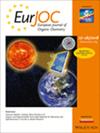负载钯的纤维素基纳米海绵作为高效非均相催化剂用于合成具有药物相关性的具有挑战性的衍生物
IF 2.7
3区 化学
Q2 CHEMISTRY, ORGANIC
引用次数: 0
摘要
开发高效的催化体系是合成复杂杂环化合物的关键。然而,关键的基序,如吡啶和呋喃衍生物,由于区域选择性和对恶劣条件的敏感性,带来了挑战。传统的均相钯催化交叉偶联反应虽然有效,但存在催化剂回收问题、钯污染和环境问题。为了克服这些限制,本研究探索了纤维素基纳米海绵作为多相催化的可持续钯载体,增强了稳定性和绿色化学整合。这些由纤维素合成的纳米结构材料提供了一个高表面积的支架,增强了均匀的钯分散,使用电感耦合等离子体光学发射光谱测量的总负载为22% w/w,并防止金属浸出,整合了绿色化学原理和安全和可持续的设计方法。本文介绍了在温和条件下使用CNS - Pd对Suzuki-Miyaura偶联进行优化,展示了这种多相催化剂在合成药学相关杂环衍生物方面的效率和选择性。值得注意的是,即使使用不稳定的硼衍生物,也可以实现高反应收率(65%-99%),这些不稳定的硼衍生物通常使用均相催化剂合成,通常收率、选择性和最终产物纯度都很差。获得的结果强调了基于生物聚合物的催化剂在推动可持续药物合成创新方面的潜力,有效地弥合了多相催化和药物化学之间的差距。本文章由计算机程序翻译,如有差异,请以英文原文为准。
Cellulose‐Based Nanosponges Loaded with Palladium as Efficient Heterogeneous Catalysts for the Synthesis of Challenging Derivatives with Pharmaceutical Relevance
Developing efficient catalytic systems is crucial for synthesizing complex heterocyclic compounds used in pharmaceuticals. However, key motifs, like pyridine and furan derivatives, pose challenges due to regioselectivity and sensitivity to harsh conditions. Conventional homogeneous palladium‐catalyzed cross‐coupling reactions, while effective, suffer from catalyst recovery issues, palladium contamination, and environmental concerns. To overcome these limitations, this study explores cellulose‐based nanosponges as sustainable palladium supports for heterogeneous catalysis, enhancing stability and green chemistry integration. These nanostructured materials, synthesized from cellulose, provide a high‐surface‐area scaffold that enhances uniform palladium dispersion, with a 22% w/w overall loading measured using inductively coupled plasma optical emission spectroscopy, and prevents metal leaching, integrating green chemistry principles and a safe‐and‐sustainable‐by‐design approach. In this work, the optimization of Suzuki–Miyaura couplings using CNS‐Pd under mild conditions, showcasing the efficiency and selectivity of this heterogeneous catalyst in the synthesis of pharmaceutically relevant heterocyclic derivatives, is presented. Notably, high reaction yields (65%–99%) even with unstable boronic derivatives are achieved, which are typically synthesized using homogeneous catalysts, often with poor yields, selectivity and purity of the final products. The obtained results underscore the potential of biopolymer‐based catalysts to drive innovation in sustainable pharmaceutical synthesis, effectively bridging the gap between heterogeneous catalysis and pharmaceutical chemistry.
求助全文
通过发布文献求助,成功后即可免费获取论文全文。
去求助
来源期刊
CiteScore
5.40
自引率
3.60%
发文量
752
审稿时长
1 months
期刊介绍:
The European Journal of Organic Chemistry (2019 ISI Impact Factor 2.889) publishes Full Papers, Communications, and Minireviews from the entire spectrum of synthetic organic, bioorganic and physical-organic chemistry. It is published on behalf of Chemistry Europe, an association of 16 European chemical societies.
The following journals have been merged to form two leading journals, the European Journal of Organic Chemistry and the European Journal of Inorganic Chemistry:
Liebigs Annalen
Bulletin des Sociétés Chimiques Belges
Bulletin de la Société Chimique de France
Gazzetta Chimica Italiana
Recueil des Travaux Chimiques des Pays-Bas
Anales de Química
Chimika Chronika
Revista Portuguesa de Química
ACH—Models in Chemistry
Polish Journal of Chemistry.

 求助内容:
求助内容: 应助结果提醒方式:
应助结果提醒方式:


